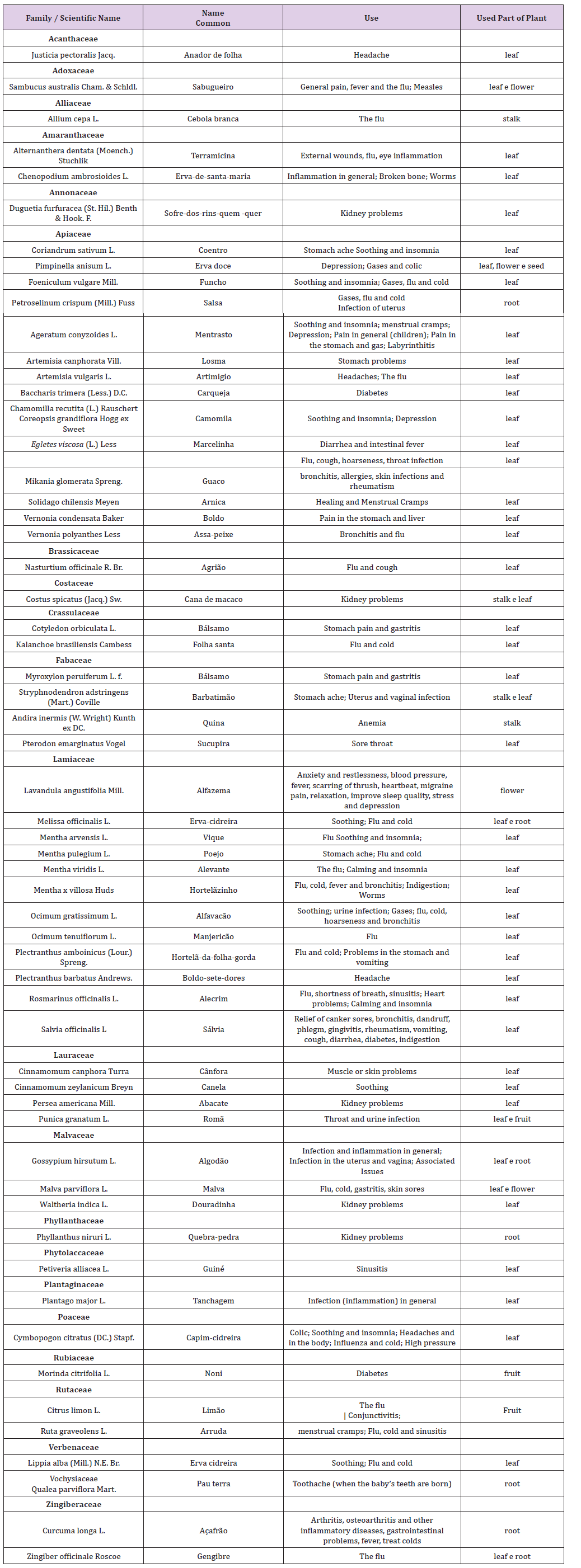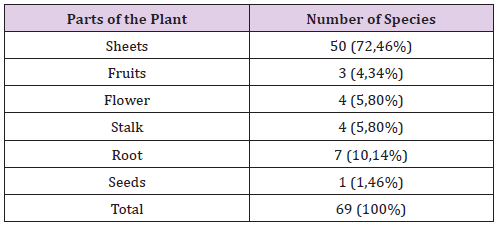Impact Factor : 0.548
- NLM ID: 101723284
- OCoLC: 999826537
- LCCN: 2017202541
Matheus Vinicius Abadia Ventura*1, Estevam Matheus Costa2 and Marcio Moacir Bessa2
Received: July 19, 2018; Published: July 30, 2018
*Corresponding author: Matheus Vinicius Abadia Ventura, Goiano Federal Institute, Rio Verde – GO, Brasil
DOI: 10.26717/BJSTR.2018.07.001501
Medicinal plants include plant species with medicinal properties, which in some cases are used for specific purposes of healing or prevention. Thus, ethnobotanica is the rescue of this traditional knowledge, related to the use of this flora as a resource. The objective of this article was to carry out a bibliographic review, adopting documentary research as a criterion based on articles published in renowned national and international journals specializing in the ethnobotanical aspects of medicinal plants reported in the state of Goiás. Most interviewees responded to use plants for for medicinal purposes, with women being the majority. In addition, leaves are the most used parts for different diseases. The use of medicinal plants is a widely used practice among residents of the cities (Goianésia and Ipameri, Goiás). In general, the species indicated by the inhabitants in the ethnobotanical survey demonstrated the potential for pharmaceutical use, since they presented some compounds known to be important.
Keywords:Lamiaceae; Asteraceae; Flora; Tradition
Brazil presents the greatest biological diversity in the world, possessing a rich flora arousing the interests of scientific communities for study and conservation of these resources [1]. Thus, ethnobotanica is the rescue of this traditional knowledge, related to the use of this flora as a resource [2,3], since man has not lost the close relationship with plants and nature, bringing him individual benefits [4]. The medicinal plants comprise plant species with medicinal property, which in some way is used for specific purposes of cure or prevention [5,6] From surveying in certain communities it is possible to ascertain the vegetation resources and their benefit in several factors, which are transferred from generation to generation [7]. The objective of this article was to carry out a bibliographic review, adopting documentary research as a criterion based on articles published in renowned national and international journals specialized in ethnobotanical aspects of medicinal plants reported in the state of Goiás.
An ethnobotanical bibliographical survey was carried out on reputed pulicated articles that cataloged the species in two important cities in the state of Goiás. The ethnobotanical survey of medicinal plants were carried out through documentary research in the following locations described in Table 1. The informational survey in the city of Ipameri - GO conducted by [8] was conducted in the period from August 2008 to June 2009 where 200 people were interviewed. In the city of Goianésia, the survey period was made from May to June 2013 by [9], where 50 people were interviewed.
Table 1: Locations used in ethnobotanical surveys.

[8] observed in the city of Ipameri, in Goiás, where 200 families were interviewed, 75 of whom stated that they did not use medicinal plants, and the other 125 reported doing so (54% female and 46% female male), representing 62.5%, and Silva & Faria (2014), observed that in Goianésia - Goiás, 48 of the 50 people interviewed (41 females and 9 males) use plants for medicinal purposes ( 96%). According to [10,11] there is a predominance of women with greater use due to greater presence during the day at home in the performance of domestic activities, which was not demonstrated in the work of [8,12], which despite being greater than half, did not present a significant superiority [13] observed that 70% of the interviewees were female.
In both, the surveys cited the species used by the interviewees for medicinal purposes, totaled 61 species in 23 families as shown in Table 2, and the popular names, the medicinal use and the part of the plant used were also described. In the city of Ipameri - Goiás, in the survey of [8], the species that have stood out because they are the most used are quebra-pedra (Phyllanthus niruri L.), camomila (Chamomilla recutita (L.) Rauschert.), hortelãrasteira (Mentha x villosa L.), poejo (Mentha pulegium L.), funcho (Foeniculum vulgare Mill.), babosa (Aloe vera L.) malva (Althaea officinalis L.), guaco (Mikania glomerata Spreng.), mentrasto (Ageratum conyzoides L.), alfavacão (Ocimum gratissimum L.), losna (Artemisia canphorata Vill.), bálsamo (Eysenhardtia platycarpa Mich.), carqueja (Baccharis trimera (Less.) DC.), boldosete- dores (Plectranthus barbatus Andrews.), and capim-cidreira (Cymbopogon citratus (DC.) Stapf.)
Table 2: Plants used for medicinal purposes identified in the cities of Goianésia - GO and Ipameri - GO.

[9] in Goianésia - Goiás, reported that the five medicinal species most used by the residents were hortelã da folha gorda (Plectranthus amboinicus (Lour.) Spreng.), alecrim (Rosmarinus officinalis L.), hortelãzinho (Mentha x villosa Huds), boldo (Vernonia condensata Baker) and capim cidreira (Cymbopogon citratus (DC) Stapf.), Among the 61 species mentioned within the 23 families, the family that includes the largest number of species is Lamiaceae (12 species) and Asteraceae (11 species). Souza & Felfili (2006) observed in their work in the city of Alto Paraiso in Goiás, that the predominant families were Fabaceae (12 species) and Asteraceae (14 species). It is necessary to reinforce that the work of [8] (8 species) and Lamiaceae (10 species) were the predominant species. With this, we observe the diversity of species within the state of Goiás. Of the 61 species described and raised, the most frequently used plant parts were leafy leaves, as described (Table 3). The leaves were also the most cited among those interviewed in the works of [4,14]. Of the 61 species raised, the use of medicinal plants, according to the interviewees, has the purpose, mostly to cure pain and flu. The same result was also found for [11,14], where most of the interviewees cited species to cure influenza, fever and pain.
Table 3: Parts of the plant most used in production for medicinal purposes.

The use of medicinal plants is a widely used practice among city dwellers (Goianésia and Ipameri, Goiás), although not all the inhabitants cultivate the plants, they did not abandon the practice of using them, acquiring them when necessary, by means of relatives and neighbors. In general, the species indicated by the inhabitants in the ethnobotanical survey demonstrated the potential for the pharmaceutical use, since they demonstrate some compounds that are recognized as important, in addition, the use is independent of the sex and extends to diverse age groups and socioeconomic, representing an alternative to the consumer market. But anatomical and pharmacological studies of these plants are suggested to give greater reliability.


